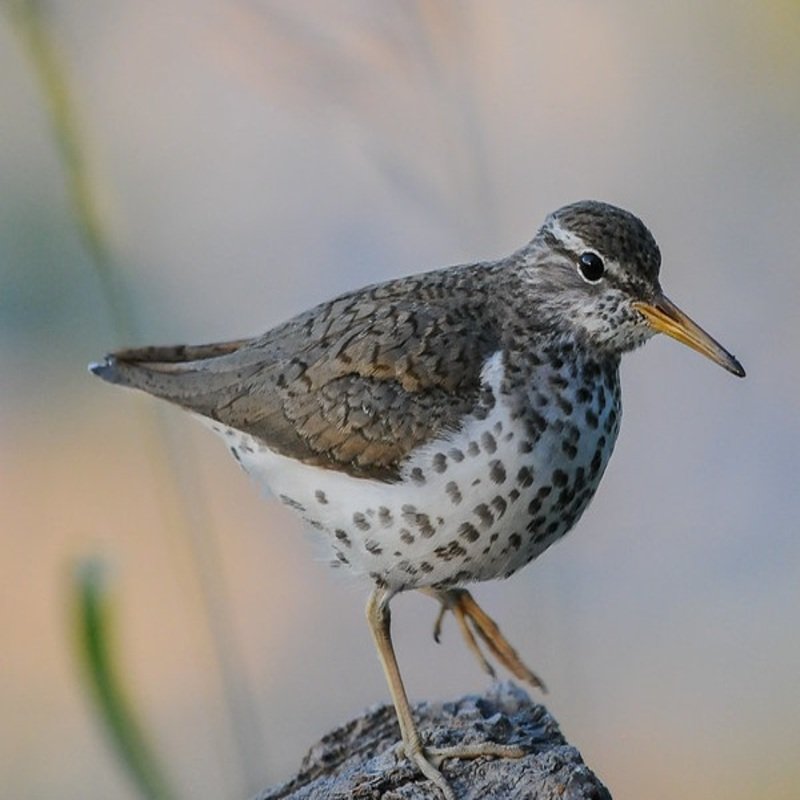A little shorebird, the spotted sandpiper (Actitis macularius) is a sandpiper. It shares the genus Actitis with its sister species, the common sandpiper. They geographically supplant one another; wandering birds may settle with breeders of the other species and hybridize.
Quick Overview: Actitis Macularius – Spotted Sandpiper
Body size: Around 7.5 in (19 cm) and a weight of 64 g (2.25 oz)
Main colors: Brown, Olive-gray, White, Black
Range: Throughout the United States
Migratory Bird: Yes
Best time of the year to see in the U.S.: June, July, August, September
Conservation Status: Least Concern
Spotted sandpiper Description
Spotted sandpipers are medium-sized sandpipers. The crown, nape, back, and wings of spotted sandpipers are brown to olive-gray, while the face, neck, chest, and belly are dazzling white. Their common name refers to the large black dots that cover their white undersides. In comparison to males, females have larger markings that reach lower on the belly. When spotted sandpipers fly, they exhibit a white wing stripe and a plain rump and tail.

Size
These birds have a length of 7.5 in (19 cm) and a weight of 64 g (2.25 oz). Their wings could range from 13-14 in (33-36 cm).
Feeding
By probing their bills into sand and mud, the Spotted Sandpiper feeds mostly on insects such as midges, flies, grasshoppers, beetles, worms, snails, and small crustaceans. Additionally, they will consume small and dead fish.
Habitat
Spotted sandpipers breed in a variety of habitats from sea level to 4,700 m in elevation. Females defend a breeding territory that often comprises a shoreline (of a stream or lake, for example), a semi-open region for nesting, and areas of dense vegetation.
Behavior
The spotted sandpiper is a diurnal bird. They can sleep at any time of the day or night, but prefer to do so when it is dark. During the day, spotted sandpipers spend time grooming, rubbing their heads, stretching, and bathing. Spotted sandpipers are completely migratory, save for populations that nest and winter along the west coast of the United States and in select parts of California. The spotted sandpiper migrates both day and night. In contrast to the majority of shorebirds, they move alone or in small groups.
Actitis Macularius Scientific Classification
- Kingdom: Animalia
- Phylum: Chordata
- Subphylum: Chelicerata
- Class: Aves
- Order: Charadriiformes
- Family: Scolopacidae
- Genus: Actitis
- Species: Actitis macularius
Best time of the year to see
The best time to see these birds in the United States is during the summer season (June – September).
Distribution of the Spotted sandpiper in the USA
Breeds from northern Alaska and Canada to the southern United States. It is a resident along the Pacific coast south of British Columbia and winters in southern states all the way to South America.
The Spotted sandpiper can be found in the following states in the United States – Alabama, Arizona, Arkansas, California, Colorado, Connecticut, Delaware, Florida, Georgia, Hawaii, Idaho, Illinois, Indiana, Iowa, Kansas, Kentucky, Louisiana, Maine, Maryland, Massachusetts, Michigan, Minnesota, Mississippi, Missouri, Montana, Nebraska, Nevada, New Hampshire, New Jersey, New Mexico, New York, North Carolina, North Dakota, Ohio, Oklahoma, Oregon, Pennsylvania, Rhode Island, South Carolina, South Dakota, Tennessee, Texas, Utah, Vermont, Virginia, Washington, West Virginia, Wisconsin, and Wyoming.
